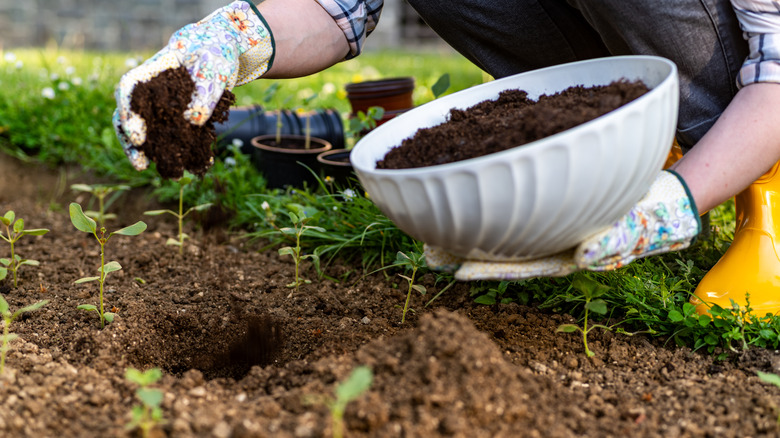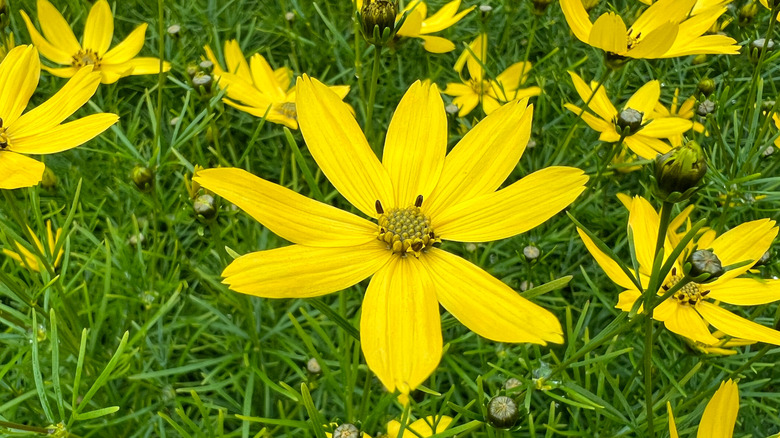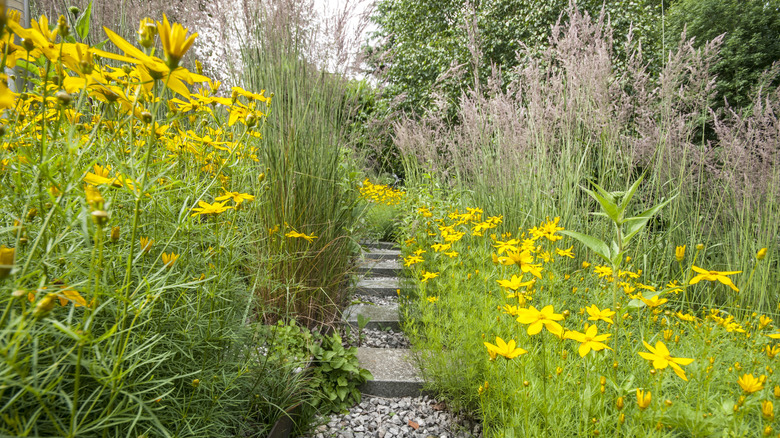Don't Wait: Plant This Flowering Perennial In November For Cheery Summer Blooms
While many are settling into dormancy, some plants are just getting started when temperatures drop in November. This is the time when hopeful gardeners set up for spring and summer by planting bulbs that start their growth journey underground. Native perennials that flower in the spring can also be a perfect choice to plant in November, not only for the cheerful meadow vibes they bring to the garden, but also because they're adapted to the soil conditions and may need less attention from you. Threadleaf coreopsis (Anacis verticillata, previously known as Coreopsis verticillata), which is native to the eastern half of North America, delivers both of these benefits. This daisy-like native perennial plant can tolerate droughts and poor soil while treating you to bright yellow blooms. Plant threadleaf coreopsis in November by prepping the soil with compost, digging a hole, and transplanting it from a nursery container.
Planting coreopsis in November is beneficial for a number of reasons. There are fewer pests to worry about and there's less risk of plant diseases developing. Also, November planting helps them get established and come back vigorously in the spring. Even though the air temperature may be cold, the soil is still warm in November, and roots can grow faster when the plant isn't drying out in the heat.
Threadleaf coreopsis grows well in USDA Hardiness Zones 3 through 9. Keep in mind that your ability to plant threadleaf coreopsis in November varies depending on where you live, since you should ideally finish autumn planting at least six weeks before the first frost. Do a little research to find out when to expect the first frost in your region. In much of the Northeast, it may happen in October, while gardeners in southern states can experience their first freezes in mid-November or later.
Grow threadleaf coreopsis for blooms, pollinators, and easy growth
Threadleaf coreopsis, sometimes known as threadleaf tickseed, has a bushy growing habit and is often grown in garden borders or among other pollinator-friendly plants. The plant is known to reach up to 3 feet tall and bloom for a long stretch of time in the spring, summer, and even into fall. It also has thin, feathery leaves. In addition to the vibrancy and garden interest it provides, this native perennial is attractive to bees and other insects that aid the garden, but luckily, it's not attractive to deer. Although this coreopsis can survive periods of drought once it takes hold in the garden, any rain that often comes in November can help fulfill its need for more watering until it matures.
When planning your November planting, make sure you reserve a sunny location for your threadleaf coreopsis. It's also handy to use some of the compost you may have saved up over the summer, adding it to the soil as you plant this perennial. Although compost should be added to help the soil drain well, threadleaf, like other species of coreopsis, will still thrive in poor and rocky soil, in addition to soils that contain clay and sand. Its rhizomes tend to easily take hold and spread, sometimes aggressively. When you get the plants started in November, they'll go dormant when freezing temperatures occur, but their root structures will branch out and strengthen, remaining strong and healthy in the warmer months. After the first year of growth, you can trim the plant and deadhead spent blooms to keep its spread in check while encouraging more blooming.
Tips for planting and caring for threadleaf coreopsis
Like other perennials, you can transplant threadleaf coreopsis from a container or a plug bought from a nursery. This may give it a better chance of taking hold more quickly than if you grow it from seed. Choosing November as your planting time helps with this, since the warmer soil temperature combined with air that isn't too hot reduces the shock the plant undergoes when it's transplanted. Shake out the roots, plant it in a hole that's as deep as the roots go but a little wider, add your compost, and make sure the base of the plant lines up with the top of the ground. Leave 12 to 18 inches between the plants if you're transplanting multiple seedlings into your garden. This is important because good airflow between the plants helps stave off humid, crowded conditions that invite a few issues common to tickweed flowers, like powdery mildew and other fungal infections.
Once you've planted it, check on the coreopsis every week, giving it water if the soil is dry. When they're established, avoid overwatering them or watering the plants from above; they're not at their best in soggy soils. You can fertilize sparingly in the spring, but too much fertilizer could reduce the flowering. In most areas, blooms will emerge around May and last well into July. These perennials may need to be divided every two years or so, which you can accomplish by digging up and cutting the roots into several sections. Do this especially if your plants look droopy or overcrowded, but it's also a good practice for maintaining enough air circulation.


